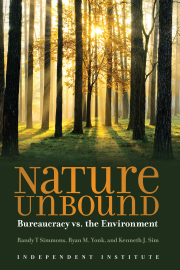Little wonder property owners often adopt a “shoot, shovel and shut-up” approach to endangered species. Should you discover a member of a government-certified endangered species on your property, you are required to give up any use of your property federal agents consider threatening to the species or its habitat—and you will not be reimbursed for lost income.
Even though the roots of the American experiment are limited government and individual freedom, the core features of the Endangered Species Act are coercion, expanding government and the bureaucratic shifting of social costs to individuals. But does preserving endangered species require that sweeping powers be given to government? No. Many endangered species can “pay their own way.”
In the United States many species already pay their own way. For instance, in 1979 the U.S. Fish and Wildlife Service allowed commercial breeding of American alligators. Since then, alligator farming has become so successful that wild populations have exploded. One entrepreneur is even going to raise alligators in a warm-springs area in southern Idaho.
Yet there are many who won’t let other species pay their way. The Fish and Wildlife Service, for example, in 1983 rejected a proposal to allow the commercial use of captive-bred green sea turtles even as the British, on the Grand Cayman, and the French, on Reunion Island, were showing that commercial efforts successfully help boost wild sea turtle populations.
The private, for-profit Grizzly Discovery Center in West Yellowstone, Montana, is likewise being stalled. The center’s owner, Lewis Robinson, wants to create a park where the public could see grizzly bears up close. He proposes stocking the park with up to 18 nuisance bears from national forests or private properties—park rangers routinely kill nuisance bears—but the U.S. Fish & Wildlife Service will not allow him to have any of its nuisance bears.
Activists have joined with the bureaucrats. A member of the Greater Yellowstone Coalition, a local environmental group, was quoted in Newsweek as saying she would rather see the bears killed than put into the “artificial” habitat of the private park.
Nevertheless, there is a slight opening of the environmental mind under way: for instance, David Western, head of the Kenya Wildlife Service, recently admitted, “Wildlife must have value.”
To be sure, there are many lessons to be learned from domestic experiments in providing incentives for the environment to have economic value. Mill Creek Canyon, east of Salt Lake City, for instance, is a model of market-based preservation.
Mill Creek Canyon is a publicly-owned open-space that at one time was experiencing phenomenal use (upwards of 400,000 visitors a year) but was receiving only $3,000 per year from the Forest Service for upkeep.
Salt Lake County decided to build a tollbooth just outside the canyon and now collects a modest $2 toll on automobiles. Revenues are given to the Forest Service under condition they be spent on the canyon. The toll now generates $175,000 per year for riparian restoration, watershed protection and control and disposal of human and pet waste.
Voluntarism should likewise not be overlooked in our efforts to protect and breed more endangered species.
Consider the Peregrine Fund, a private foundation that raises Peregrine falcons in captivity and then releases them. Because of its effort, today there are more pairs of Peregrine falcons nesting in New Jersey than at any time since records have been kept—thanks to private efforts, not government or the Endangered Species Act, its asset forfeiture requirements being in desperate need of reform for man and wildlife alike.












